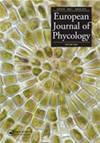日本琉球群岛珊瑚泻湖中与毛囊藻亚属相关的Pyramimonas属两新种(Pyramimonadophyceae,Chlorophyta)
IF 1.7
4区 生物学
Q2 MARINE & FRESHWATER BIOLOGY
引用次数: 0
摘要
摘要本文测定了从珊瑚礁碎屑中分离的两种新的底栖Pyramimonas的特征。其中一种是超级假单胞菌,与新月假单胞菌最相似,尽管其在产生粘液方面具有独特性,但其形态特征套件和分子系统发育信号支持其成为毛囊亚属的一员。另一个,P.lamellipunctata sp.nov.,也使用部分SSU数据显示了与毛囊亚属的系统发育关系。然而,使用rbcL数据,第二个物种与粘液点状物种一致,尽管该分支存在问题,因为它包括Pterosperma属。从形态学上讲,片状泪点藻的细胞与具有粘液点的物种有许多共同的特征,但也与这一群体表现出重要的差异,最显著的是缺乏粘液,这表明它们形成了一个独特的谱系。亮点● 利用SSU数据表明,两个新的Pyramimonas属是毛孢子亚属的成员。● rbcL数据仅支持其中一个新种的这种关联,并将另一个与Punctae亚属的粘液物种相关联。● 形态学数据仅部分支持与点状物种的第二种隶属关系,从而推断出一个独特的谱系。本文章由计算机程序翻译,如有差异,请以英文原文为准。
Two new species of Pyramimonas (Pyramimonadophyceae, Chlorophyta) associated with the subgenus Trichocystis from coral lagoons of the Ryukyu Archipelago, Japan
ABSTRACT The characteristics of two new benthic species of Pyramimonas isolated from coral rubble have been determined. One, P. superba sp. nov., most similar to P. lunata, has a morphological character suite and molecular phylogenetic signal supporting it as a member of the subgenus Trichocystis, despite its uniqueness in producing mucilage. The other, P. lamellipunctata sp. nov., also shows phylogenetic affiliation with the subgenus Trichocystis using partial SSU data. However, this second species aligns with muciferous punctate species using rbcL data, although the clade is problematic as it includes the genus Pterosperma. Morphologically, cells of P. lamellipunctata share many features with muciferous punctate species but also exhibit important disparities with this group, most notably a lack of mucilage, suggesting that they form a unique lineage. HIGHLIGHTS ● Two new species of Pyramimonas are indicated as members of the subgenus Trichocystis using SSU data.● rbcL data only supports this association for one of the new species and affiliates the other with muciferous species of the subgenus Punctatae.● Morphological data only partially supports the second affiliation with punctate species, thereby inferring a unique lineage.
求助全文
通过发布文献求助,成功后即可免费获取论文全文。
去求助
来源期刊

European Journal of Phycology
生物-海洋与淡水生物学
CiteScore
4.80
自引率
4.20%
发文量
37
审稿时长
>12 weeks
期刊介绍:
The European Journal of Phycology is an important focus for the activities of algal researchers all over the world. The Editors-in-Chief are assisted by an international team of Associate Editors who are experts in the following fields: macroalgal ecology, microalgal ecology, physiology and biochemistry, cell biology, molecular biology, macroalgal and microalgal systematics, applied phycology and biotechnology. The European Journal of Phycology publishes papers on all aspects of algae, including cyanobacteria. Articles may be in the form of primary research papers and reviews of topical subjects.
The journal publishes high quality research and is well cited, with a consistently good Impact Factor.
 求助内容:
求助内容: 应助结果提醒方式:
应助结果提醒方式:


